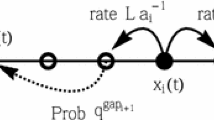We study phase transitions of a system of particles on the one-dimensional integer lattice moving with constant acceleration, with a collision law respecting slower particles. This simple deterministic “particle-hopping” traffic flow model being a straightforward generalization to the well known Nagel–Schreckenberg model covers also a more recent slow-to-start model as a special case. The model has two distinct ergodic (unmixed) phases with two critical values. When traffic density is below the lowest critical value, the steady state of the model corresponds to the “free-flowing” (or “gaseous”) phase. When the density exceeds the second critical value the model produces large, persistent, well-defined traffic jams, which correspond to the “jammed” (or “liquid”) phase. Between the two critical values each of these phases may take place, which can be interpreted as an “overcooled gas” phase when a small perturbation can change drastically gas into liquid. Mathematical analysis is accomplished in part by the exact derivation of the life-time of individual traffic jams for a given configuration of particles.
Similar content being viewed by others
References
R. Barlovic, T. Huisinga, A. Schadschneider, and M. Schreckenberg, Open boundaries in a cellular automaton model for traffic flow with metastable states, Phys. Rev. E 66, 046113:11 (2002).
M. Blank (2001) ArticleTitleDynamics of traffic jams: order and chaos Moscow Math. J. 1 IssueID1 1–26
M. Blank (2003) ArticleTitleErgodic properties of a simple deterministic traffic flow model J. Stat. Phys. 111 IssueID3–4 903–930 Occurrence Handle10.1023/A:1022806500731
D. Chowdhury L. Santen A. Schadschneider (2000) ArticleTitleStatistical physics of vehicular traffic and some related systems Physics Rep. 329 199–329 Occurrence Handle10.1016/S0370-1573(99)00117-9
H. Fuks (1999) ArticleTitleExact results for deterministic cellular automata traffic models Phys. Rev. E 60 197–202 Occurrence Handle10.1103/PhysRevE.60.197
L. Gray D. Griffeath (2001) ArticleTitleThe ergodic theory of traffic jams J. Stat. Phys. 105 IssueID3/4 413–452 Occurrence Handle10.1023/A:1012202706850
S. Krauss P. Wagner C. Gawron (1996) ArticleTitleContinuous limit of the Nagel-Schreckenberg model Phys. Rev. E 54 3707–3712 Occurrence Handle10.1103/PhysRevE.54.3707
S. Krauss P. Wagner C. Gawron (1997) ArticleTitleMetastable states in a microscopic model of traffic flow Phys. Rev. E 55 5597–5602 Occurrence Handle10.1103/PhysRevE.55.5597
R. LeVecque (1990) Numerical Methods for Conservation Laws Lectures in Mathematics ETH Zurich Birkhauser, Basel
E. Levine G. Ziv L. Gray D. Mukamel (2004) ArticleTitlePhase transitions in traffic models J. Stat. Phys. 117 IssueID5–6 819–830 Occurrence Handle10.1007/s10955-004-5706-6
T. M. Liggett (1999) Stochastic interacting systems: contact, voter, and exclusion processes Springer-Verlag NY
M. J. Lighthill G. B. Whitham (1955) ArticleTitleOn kinematic waves: II. A theory of traffic flow on long crowded roads Proc. of R Soc. A 229 317–345
K. Nishinari M. Fukui A. Schadschneider (2004) ArticleTitleA stochastic cellular automaton model for traffic flow with multiple metastable states J. Phys. A 37 3101–3110
K. Nagel M. Schreckenberg (1992) ArticleTitleA cellular automaton model for freeway traffic J. Physique I 2 2221–2229 Occurrence Handle10.1051/jp1:1992277
K. Nishinari D. Takahashi (1998) ArticleTitleAnalytical properties of ultradiscrete Burgers equation and rule-184 cellular automaton J. Phys. A 31 IssueID24 5439–5450
A. Schadschneider M. Schreckenberg (1997) ArticleTitleTraffic flow models with ‘slow-to-start’ rules Ann. Physik 6 541 Occurrence HandleMR1483979
H. M. Zhang (1999) ArticleTitleA mathematical theory of traffic hysteresis Transport. Res. B 33 1–23 Occurrence Handle10.1016/S0191-2615(98)00022-8
Author information
Authors and Affiliations
Corresponding author
Additional information
This research has been partially supported by Russian Foundation for Fundamental Research and French Ministry of Education grants.
Rights and permissions
About this article
Cite this article
Blank, M. Hysteresis Phenomenon in Deterministic Traffic Flows. J Stat Phys 120, 627–658 (2005). https://doi.org/10.1007/s10955-005-5959-8
Received:
Accepted:
Published:
Issue Date:
DOI: https://doi.org/10.1007/s10955-005-5959-8




